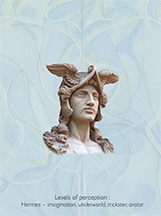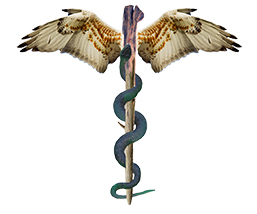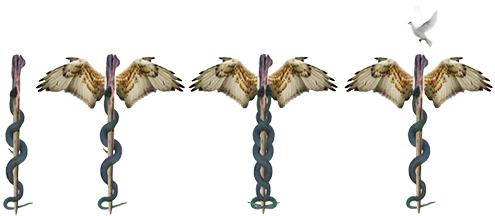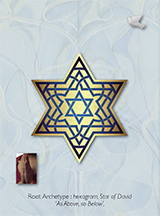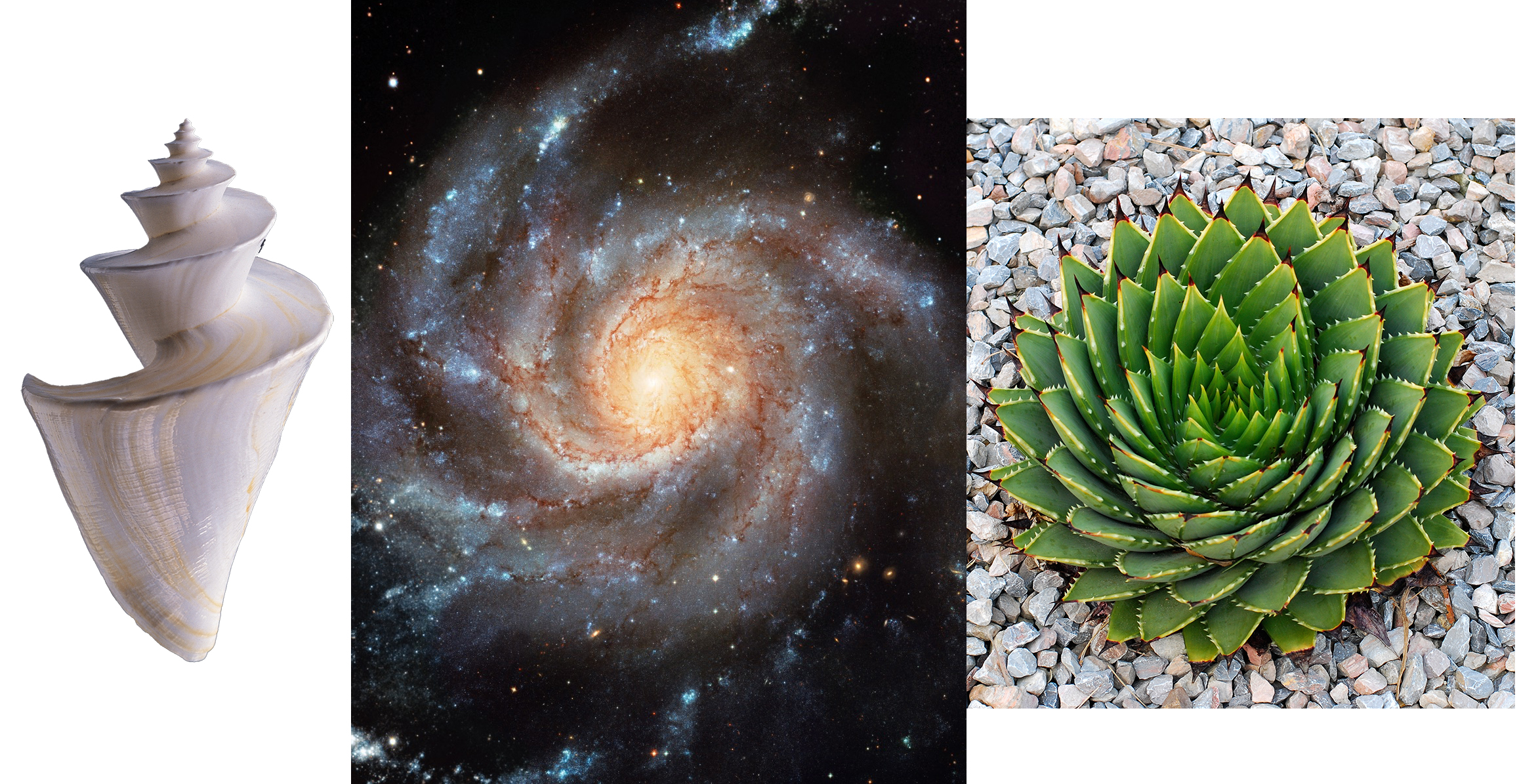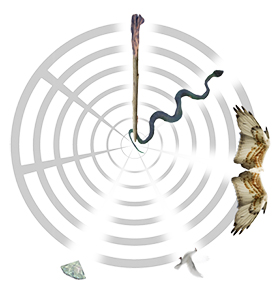An ontological understanding of the rôle of the somatic body as a spiritual instrument
The evolution of human consciousness and reasoning are often sidelined by doctrines of religious exegesis (which are rightly resistant to modernist reinterpretation of texts and their meanings). In fact, the two are companions.
This narrative will explain the epigenesis of an internal understanding of the action (of grace) by the Supreme Deity upon human beings. Through the movement from the monad (matter), to duality and then to a trinity, and onwards to a representational series of symbols known by the algorithm 5+4, a spiritual reality can be conveyed and adopted as a moniker for the emergence of both internal (spiritual) and external health (temporal). These symbols represent the various aspects of self and qualities that act to bridge or drive the emergence of a human or their culture. These selves live within an interior castle (our somatic body), each within their own mansion or niche. Using symbols, we can see ourselves in an ordered manner but also note how life can manipulate the internal order of these elements, and move parts of us to and from particular niches. This symbol language and pictograms help illustrate changes of state or patterns by which we are held. This understanding is the cornerstone for an initial parallel and ultimately united relationship with the client [of business] and the participant in a religious or spiritual life.
First, we will clarify the use of iconography, and then we will look at the evolution of the rod of Asclepius (an iconic representation of the core elements in healing) to the modern Hermetic single or double caducei. These are the staircases within our castle.
Iconography
One of the reasons to study iconography is to note how graphic images may convey an ontological origin or nuance at a symbolic level. We in Subud have a meaningful symbol, which although recognizable to us, may be alien to many people. However, the very substance of the artwork conveys meaning. The circles repeated may remind people of Matryoshka dolls, of unity, of realms within realms, of something contained, or even a maze! The radiating lines may cause them to pause, but the graphic simply informs that that some lines transect through the whole, they radiate like the sun or beams of Light.
The radiating lines have been a source of inquiry by many of us, even with the sometimes conflicting descriptions of what they may mean; Mohammed Bapak’s slightly varying explanations of the Holy Spirit–the Ruh Ilofi as the dissecting Holy force and yet again, sometimes naming another Holy life force, the Ruh Qudus as enveloping the seven natures.
Are there readily explainable maps of what these lines may mean? The seven natures we can understand; as the emanation model has been articulated since Aristotle and his student Plotinus. The dissecting lines prove much more of a problem. We can ourselves, dissect Bapak’s explanations of a guiding Light-filled Ruh that penetrates the universe, that has an enveloping companion to it. We can then note a gender relationship between the two–one that is masculine; it penetrates; this is the mystical union, “Wahdat” (Arabic: unity), oneness, and the contact that we know in the “Latihan Kedjiwaan” (Spiritual Exercise). The second accompanies and is feminine in essence, for it embraces and carries the participant in Mercy and Grace, the accompanying spirit–the Ruh Qudus.
The Caduceus
In the nineteenth century, the medical establishment adopted a symbol used in the printer’s trade to represent medicine. This was because iconography is a visual gestalt representation to convey information not readily understood. This symbol was the caduceus of Hermes, and/or Mercury, which was mistaken for the rod of Asclepius. Regardless of whether the symbol was erroneously or mistakenly used, we are witness to an evolution of a specific icon that conveys perhaps a new paradigm or at least new information. The Caduceus can be seen to have evolved from Asclepius’ simple rod and snake to a more sophisticated single or double-snaked central rod and wings.
The evolution of this icon conveys many different meanings. Scholars have variously concluded that the rod is a potent symbol of authority (or the animal spine), the snake is the poison that can heal, or the double snakes as analogous to the autonomic nervous system, or system of plexi or chakras in the body.
I suggest we take a fresh look at the caduceus and to the following: The most fundamental meaning, is a symbol of a holomovement: Implicate and Explicate orders acting upon a middle ground or substance. David Bohm, the physicist, considered that a central Implicate [enfolded] reality (the authority and Presence of the Divine Word or ‘be’) operated through everything. An Explicate [unfolded] reality (our archetypal world of seemingly separate and unrelated things as well as events in time and space) surrounded a single unified wholeness. Meaning material things, space, and time unfold around an underlying order.
Above left: Aesculapius’s staff and snake, Middle and middle right: Single and double (duality of life) caducei
Right: the caduceus as an act of submission
The single rod or central axis could be said to illustrate a unified singularity–the implicate reality. The entwined snake represents the carrier of life, the unfolding of the explicate reality. The use of the double snake may represent a further movement away from the origin, to the duality of phenomena. Bohm refers to this as a middle substance. The eagle’s wings symbolically represent Light or “that which is carried” – the virtual photons that coexist, appear, and disappear (as waves or particles) within the vacuum field of nature. Some physicists consider these photons to be an informational field as they are carriers for the electromagnetic force.
In theology, it could be said that the eternal debate of “what is God,” and whether God is knowable, will be endless. However, there is a generally agreed-upon model of explanation called Emanationism. Emanation infers that God wants to be known and that His Essence pours out (the Implicate) through emptiness where it eventually lands (incarnates) and enfolds into matter. The living essence, or spirit, now inhabiting a material body, about-turns and begins its long journey back towards its origin. This clothed spirit emerges through cycles of unfolding (the Explicate) levels as it rises through successive levels of being or consciousness.
Hexagram – Hermetic maxim: “As above, so below”
Spirals in nature, and the cosmos
Along with the maxim “as above, so below,” the existence of these eternal signs (the Caduceus) is also evident as developing in the human corpus, in the principle of ascendant and descendent forms of energies, and in the emergent properties of all living things. Consider the spiral nature of life and its underlying patterns: weather formations; water draining down a sinkhole; the spiral arrangement of plants, fascia, and musculature in the body, or the twist in the DNA strand. The essence of the Caduceus (staff, snake(s), and wings) can be amplified by providing a full subtext of terms that co-exist beneath each classical word (staff). Varying examples will be given throughout this narrative.
-
The staff is integrity: the essential nature of something whole; integral; complete; unified; masculine; penetrating; implicate; enfolded; One.
-
The snake is Flexibility: waveform; resonance; transformation; field; spiral; rhythm; feminine; enveloping; expansive; explicate; unfolded; “and”.
-
The eagle is reflectiveness: inferring a capacity to reflect light; mirror; produce deep thought; contain information; and embody nous (intellect or intelligence).
-
The addition of a dove symbolizes the inner requirement of the participant to submit/surrender to a Higher Authority, namely the Absolute. The dove is representational of peace; of the descent of Grace, Spirit, Ruh, and Ruach, and is the Divine action upon the human. God is known through His energies. This is the fourth dissecting line in the Subud symbol.
-
The inclusion of a diamond or jewel above the dove represents value– the inner reality of knowing how you are valued by God. This is a Grace that descends, by gift rather than a property acquired by action. e.g.. This is the fifth dissecting line of the Subud symbol.
The Subud symbol with its radiating lines represents the penetrating action of Divine Love, and its nuance, through all the realms
In Subud, it is said that the initial contact [the staff] with the spiritual is made (at the opening), this initial contact phase may take years to develop; gradually we begin to feel (and some don’t) the inner vibration (the snake: the rhythm of the inner life, the true meaning of dhikr), and then we may experience illumination; [the wings] ‘see’ ourselves, life, of things once secret (Arabic: “Sirr”), and so we then turn our lives over, not only to surrender but submission [the dove] to the One, becoming a servant to the Implicate. The descent of value through the action of the Ruh Qudus (the life force of the angelic realm) sanctifies our hearts as valuable in the sight of God and of humankind.
NB I have no idea what the other two lines mean, so they are purposefully left as is.
The exterior and interior clothing: the interior mansions of the human
What constitutes the journeyman’s clothing that we wear through life? This covering exacts particular patterns, foibles, disasters, and dynamics that lead to ill health and misfortune. Where do we acquire it from? As human’s, we incarnate through the fields of energy surrounding our parent’s enforced intimacy, copulation, sex, lovemaking, or enter the fact. We enclose ourselves with what surrounds us, and perhaps as we incarnate we are pulled to the familiar, exotic, or karmic fate. It probably doesn’t matter, as we have in Subud, an elitist model that somewhere along the line, some good ancestor worshipped God fully, and thus we were brought into this lineage, as well as the possibility of coming into proximity of Subud. Be that as it may, the interface of spirit into matter could be explained by Carl Jung’s or Joseph Campbell’s world of archetypal forms, that we enter through before incarnation. It is through these archetypal patterns that we clothe ourselves, during our initial (at least) life’s journey, transforming from one to another, discarding older less effective models to don new ones as we emerge and grow into our real Self.
This is the model of Emanation called the Great Chain of Being 24. The human is clothed in this evolutionary unfolding. The human, it is said, is composed of several selves. In our present vernacular, we may use the terms mind, body, and spirit. Others use a much more esoteric compilation of who we are, using such terms as physical, emotional, mental, etheric, astral, and causal bodies. In a simplistic way, we can categorize ourselves in differentiated levels that lead from one to the next:
Hierarchical arrangement of the human, arranged with the inner rank of each realm within
In a simplistic way, we can categorize ourselves as:
[1] matter, our constitutional body, our physical self, which is brought alive by the spirit, Ruh, pneuma, or prana–an animating principle–and given the adaptability for life through inherited …
[2] vegetal elements that bring life to our cells and their attendant systems–our physiology. These provide our rudimentary sensate capacity and provide the matrix for our future autonomic nervous system. This complex of systems is given ambulatory, defensive, sexual, and territorial ambitions through an …
[3] instinctual or animal brain and residing self, and then given thought, abstraction and reason, languages and mind via our …
[4] human neocortex. An epigenetically-driven potential is then surmised to sit above the human, representing another level of being, an …
[5] the intermediary noble station that led the unrealized towards …
[6] sainthood and …
[7] prophecy through a relationship to the Divine characterized by absolute submission and mission.
St. Teresa of Avila wrote the seminal book Las Moradas in 1577 as a guide for spiritual development. She was a Catholic nun who wrote of practical ways of prayer, as a journey of faith, to achieve union with God. It mirrored her own ascension and unity with the Godhead through a life of contemplation, prayer, and service in a Carmelite Monastery in Avila, Spain. Teresa wrote of seven dwelling places, mansions, or stages each one of us would have to undergo toward a mystical embrace within God.
We can draw an analogy with our human body. It can be seen as a house; a mansion of at least four rooms, with a fifth room–the potential realized–and two other higher realms or additional rooms that may be both developed or given as gifts (descendent) of the Divine. These rooms house differing essences of the whole, and they need to be traversed slowly and quietly through life’s wonderings (as with St. Teresa; through prayer and contemplation).
The premise of the “interior castle” suggests that the human being is composed of lesser selves (the nafsu of Islamic theology or the physical, emotional, instinctual and mental, etheric, astral, and causal bodies of contemporary times) that live in different levels or realms within our somatic being. These mansions unfold and reveal in an explicate fashion which allows the larger Self to grasp an intellectually and experientially larger notion of being. The process is emergent (vertical) and expansive (horizontal).
In early Judaic thought (as in the works of Philo Judaeus and later in the thirteenth century with Sefer Ha Zohar the seminal work on Kabbalah, and in the fourteenth century by Isaac Luria’s expositions on Kabbalah, the ideas of Emanation from the First principle to matter was elaborated in schematic form (the ten sephiroth). In these formative centuries after the turn of the millennia, Platonic thought merged into Islamic theology by Al Kindi, Al Farabi, Ibn Sina, and such works as the doctrine of Unity of Being by Ibn- al ‘Arabi.
In a similar vein Gregory Palamas, a fourteenth-century Eastern Orthodox theologian, drew a distinction by saying that God was unknowable in His essence except through His energies. Although he himself didn’t explain succinctly about these energies, he described the external manifestation of Spirit, Grace or Ruh (Arabic) or Ruach (Judaic) upon people and the effect it had on them. He did not externalize God’s Spirit, emphasizing that these were of God, but made it separate from the Trinity. In a similar vein, Nikitas Stithatos took an approximation of both Kabbalistic and Pythagorean decades and introduced the Platonic model of emanation with its roots in St. Dionysius the Areopagite’s concatenation.
Left: the mansion with its various levels or niches and staircases (bridges).
In traditional systems of medicine (TM) the physician, prescriber, or healer, is supposed, to act from a teleological (i.e. nature has goals or an outcome, a reason for its existence) framework, rather than a reductionist model of healing. They supposed that the ‘thing’ that had malfunctioned had a final cause, and thus they looked at the overall reason for failure rather than a localized misfortune. The elements of the caduceus were the key ingredients for health and for spiritual growth, once the icon was decoded and understood. The caduceus, as an emblem or mythic icon, drives the point home: that the physician or priest was the original thinker to whom people turned.
For many millennia, humans, whether in the medical field or theology, have been looking at similar patterns of understanding through similar models, only divergent due to localized modes of thought, language, prevailing culture, temperament, and environment. However, a separation occurred as we came into the age of Reasoning and Enlightenment.
Hypothesis/hypostasis
We can observe the body as a series of systems creating a holarchy. Each system is as valuable as the one that precedes it and the one that supports it. For example: a neutron, quark, or electron creates atoms. These atoms are part of molecules, which form the ground substance of an organelle that lives within a cell. These cells form tissue within an organ that is part of a system (respiratory, excretory) within an organism, that is part of a population (of humans) that forms a community. Communities exist within an ecosystem in a particular niche or biome, that is are part of a larger biosphere. In a sense, this is the reverse classification system known as the Great Chain of Being, which starts from God and is ordered and ranked all the way through the simple classification of the four kingdoms; human, animal, vegetal, and mineral or matter. Ernst Schumacher was a notable scientist (amongst many others in the same vein) who asked science to reassess the value of the great chain of being. He looked at the four kingdoms and noted that there were critical differences between the four levels. Between matter and the vegetal is life, between vegetal and animal, is consciousness, and between animal and human is self-consciousness, and these differences are ontological in essence.
Ernst Schumacher reiterated that we (as humans) contain all of these sub-elements and that they support us teleologically. By adding a fifth element we surmise that nature’s goal or ulterior motive is to evolve into something ‘other’. This is the noble part of us that acts as a bridge between the ordinary selves and the Holy.
-
‘Mineral’ = m (contains matter)
-
‘Plant’ = m + w (contains matter and life)
-
‘Animal’ = m + w + x (contains matter, life and consciousness)
-
‘Man’ = m + w + x + y (contains matter, life, consciousness, and self-consciousness)
-
‘Noble’ = m + w + x + y + z (contains matter, life, consciousness, self-consciousness & being)
The human being can be figuratively drawn as a structured organism, illustrating the four evolutionary elements that create it (and a fifth potential). We can also use a symbolic language representing the four components allowing us to illustrate states of being as well as the disorganization of the system. We can state that the human may emerge from the womb intact yet undifferentiated–very much at the mercy of its mother and environment. The child is horizontal and unable, like many higher animals, to fend for itself. It is not mobile, and it is completely dependent on its mother. Time gradually sees the child emerge from reflexive movement, coordinated movement, synchronous and contralateral movement, crawling, to being upright and then (relative) independence. We become a vertical organism able to adapt and live in variable niches, unlike most other higher animals or mammals.
Above: horizontal to vertical life
We grow through life, meeting proverbial inhibitory walls or undergoing self-imposed or culturally imposed rites of passage. This vertical progress may occur quickly, slowly, or continuously or we stop it on our own accord, often affected by forces (thought to be) bigger than us.
As we grow new inner qualities emerge: we contain what preceded us, and therefore an innate (material or historical) understanding arises within us (somehow we ‘know’ how to do something). We may become intuitive and sensitive to what is not seen but grasped from our gut and sensorial apparatus (vegetal). Our instincts may become honed and sharp, offering entrepreneurial skills and advantages (animal). Even though we may have amassed huge amounts of information, our intellect somehow has wisdom (nous) to it, rather than knowledge (integral brain or human). This wisdom emanates from the lesser elements within us, providing the neurology of remembrance of these levels.
Embryological unfolding
We can also look at our embryological unfolding, and discard the classic trimester, by mapping out a timeline of 40 weeks and dividing it into four. Not to deify Ernst Haeckel’s theory of phylogeny recapitulates ontogeny, but using the premise that generally, if a structure predates another structure in evolutionary terms, it appears earlier in the formative construction of the embryo. In this way, we can observe that the embryo unfolds over a four-part development cycle. This recapitulation illustrates the unfolding of an explicate reality through the four kingdoms.
This fourfold embryological division enables us to move from a purely physiological context to an ontological framework where each realm is incorporated into the human physical matrix. The common connection between ontogeny (to be created) and phylogeny (our evolutionary history) can help us model and illustrate that we contain the early kingdoms as embryonic patterns originating from shared evolutionary lines. Even though we know that development is a seamless process, these four kingdoms or stages are heralded by an unseen element, which is the metaphorical caduceus with its inherent qualities.
The embryonic stage lasts around 10 weeks, with the first 5-8 days or so when the zygote lies in virtual space before implantation, as an undifferentiated ‘about-to-be’ state. It then implants and around the eighth week it’s officially named a fetus rather than an embryo, and our epigenesis begins, as the ‘animal’ slowly emerges from a formless egg.
The original egg cell or ovum has two poles: an animal (future ecto- and mesoderm) and a vegetal pole (future endoderm). Cell division in the zygote occurs with the first cleavage (always along the vegetal-animal axis of the egg), the second cleavage is perpendicular to the first. This cross, as it is written in the Qur’an, is a sign. It reminds us of our origins. It is the two elements of the caduceus when brought together–the vertical (the staff and our ecto- and mesoderm) and the horizontal (the snake and our endoderm). We may be reminded that in Eastern orthodoxy the caduceus is built into the Bishop’s Crosier, with two snakes (dragons sometimes) on either side of the cross, mounted at the end of the staff. The cross as a symbol is superior to either staff or snake(s) alone.
Over the forty-week cycle, four transitional moments occur, with the fourth (birth) being the last. These moments occur at the junction point of each ten-week period. The first is the physiological moment of acceptance – the mother accepts the embryo ‘as is’ – potent, congruent, integral, and whole. If the pregnancy continues and the mother does not abort, the template is congruent. Using our iconic symbols we could place the staff (of the caduceus) – the symbol for integrity – as a bridge or transitional icon between these two parts of the timeline to represent this intact, congruent set of instructions. Around twenty weeks (slightly sooner in multiparous women) there is a moment known as the quickening. It is the time when the mother feels the movement of the fetus and knows that there is life within her. This could be symbolized by the symbol of (snake) flexibility to denote rhythm, movement, transformation, unfolding, and life. In the weeks nearing thirty, the fetus is covered in a thick gel that protects the skin. As this begins to decrease, muscle bulk increases, thalamic connections develop, the lungs mature the eyelids open and close, and the visual cortex becomes more developed. It is as if the fetus now develops the capacity to see (and later on, be reflective). This third transitional period of reflection could be illustrated by the symbol of the wings. At this point, women are often seen as being pregnant and inspire courtesy and help in others as they begin to really carry the extra weight (the animal) of their pregnancy.
The fetus then reaches its final moment when it leaves the safe environment of the uterine and is birthed into the world. This is its most dangerous moment as it surmounts the difficult journey of vaginal birth or caesarian section–dependent upon the fear the physician or institution has upon birth itself. In a similar fashion, another icon could be placed at the end as a crossing point from an inner world–safe and secure within the womb into an unknown future. Perhaps the child is in its first active yet largely unconscious surrender as it emerges into life. The mother too, surrenders to the inevitable moment of birth (or to her physicians and their needs for safety and wellbeing). In this case, there is a fourth symbol to the original caduceus, that of a dove. This symbolizes peace, promise and hope (as in Noah and the flood), surrender to the Creator or the Divine.
Above we have an accurate but incomplete timeline. If we were to place additional icons to represent the four bridges or qualities, they would look like this:
When these two models combine, the emergent human being can be said to be composed of these four elements and four qualities–the fifth is not yet shown. A constitutional body of matter (material) bridged through integrity to a physiological body that provides life (vegetal). The vegetal is bridged through flexibility to an ambulatory body that has movement, sexuality, and defence (animal). The animal is bridged through reflectiveness to a thinking body which provides less reflexive action; and more cognitive and gestalt or abstract thought and multiple languages (human).. The human is bridged through surrender towards the nobility of Selves.
The staircases with the castle – the caduceus in medical practice
In clinical osteopathic practice, the observation was made that humans who were missing the vital elements of integrity, flexibility, or reflectiveness were the clients who did not get better easily, and took a disproportionate amount of time in the surgery seeking help. It was the absence, misuse, or disordered hierarchical relationship of the elements of the caduceus that appeared to be the fundamental elements that co-created illness and disease. Specifically, they appeared to be missing the elements of the caduceus as human qualities.
These human qualities rather than their corresponding physical elements are the important factor in the induction of illness or the prevention of wellness. A physical correspondence might be the spine as a symbolic representation of integrity or the staff. It might be that their spine is, according to standard criteria (X-ray, spinal examination, digital palpation) normal or showing no abnormal characteristics, yet, the client is expressing pain and non-organic deformities (spinal scoliosis, vertebral subluxation). Through examination and clinical dialogue we assess that there may be a loss of integrity (the staff figuratively given away, broken, collapsed, morally or physically, fractured, used as a weapon, was used abusively). On the other hand, we might conclude that there is a hyper- or hypo-flexibility that is the cause of the problem. In the case of backache, as an example, we might find the client placing their ‘foot’ upon this quality of being too flexible, or that an aspect of flexibility strangled them (due to old patterns of abuse) or tied them up, restricting their choices). In the case of the clients who cannot see why they are ill, we find that they either have no reflective capacity, or that they are in the dark, or that they have not looked closely at the problem, analyzed or stepped aside to see their problem from another point of view or different perspective.
The human body contains that which is hidden. It obscures its internal natures, and their unease or disorder. The physician draws out, in dialogue, what may be going on. Obviously, the trained eye, ear, and other senses will spot the obvious when displayed in some way: aberrant behaviour, some ill-at-ease, pallor, temperature, palpation… For instance, the person who tells of hunger, temperature fluctuations, exhaustion, and upset stomach is displaying disorders at the vegetal level. We may see the animal level on display when there is a limp, a broken limb, a frozen shoulder, penile impotence, and muscular and joint problems. We may also meet psychological unease, obsession, forgetfulness, and mania when we talk to the human level. In all of these, the culprit is obvious. Less obvious may be the bone ache, the resident vibration of skeletal tissue, the deformation of our structure, the organic changes slowly encroaching on the frame, and the signal heard but not understood at the material level.
The iconographic models give us an idea of the dominance of a system; the dominance of the person’s: [1] (material) history, DNA, inherited patterns of dysfunction of skeletal and physiology aberrance, familial tics and modes of thought, [2] (vegetal) of emotions, feelings, provider or support systems-physiology, [3] (animal) habits, behaviour, sexuality, trauma-prone and [4] (human) cognitive states of psychosis, denial, separation, psora and off in the clouds.
Differentiation of niche
We can illustrate these patterns in the following examples. Our normal formative process is one of differentiation. This is the ability of the human to separate between what is ‘theirs’ and what is not, and what is of lower order and what is higher. This requires diligence, foresight hindsight, courage, and the willingness to grow through the development of all the differing selves. Personal development may include learning and study, but also the culture and development of an inner and outer life. This includes the ability to see, feel, and hear the signs of a Higher Spiritual life. It is important to be able to differentiate what comes from the Divine and what comes from life.
We start with the undifferentiated, when all the elements (material, vegetal, animal, human) of the person occupy a horizontal space/building (somatic structure). The servants (the four elements) and their energies live in the same environment. In this way the human doesn’t really know who he is, what, or who speaks for him; as he is figuratively speaking with four voices. This is because there is little differentiation in their ability to determine their interior life; signals and sensations, habits and thoughts. They all co-mingle.
Above: a horizontal, undifferentiated human
Differentiation occurs through life experiences. The human metaphorically begins to discern, exclude, shape, sift their experiences, and begin to develop qualities within them that characterize our four human qualities. This process is an emergent process within the human. An autonomous, epigenetic process occurs which begins to propel them vertically rather than horizontally. They begin to differentiate themselves from history, ancestral or familial patterns, from their prevailing culture, and start to ascend, much like a seedling towards an undefined but brighter future. They acquire goals and purpose, develop adaptability, and are cognitive of how they look to others and how they want to be seen. They may even begin to understand that when they can surrender to others, to things, to situations and thus begin to have the choice driven by destiny rather than fate.
Above: a developmental progression of refinement (the gestation of the caduceus) within the ordinary human
This ascendant state is characterized by the emergence of integrity or contact with the greater Self. Integrity is grounding in matter (one’s history) with an epigenetic drive towards origin. This internal drive is often unconscious of its goal at this stage.
Above: The birth of integrity and emergence from history, old culture and DNA, development of the masculine essence
The emergent human then starts to differentiate again. Their primary pattern is one of senses and needs. Maslow’s pyramid of needs as a classic model of function is relevant here, for the person operates from how they feel, and how they are fed and nourished. This is the realm of the senses; and at its highest accolade might be characterized by those who are ecologically minded, food purists (vegetarians, vegans), and at its lowest level would be characterized by addiction, absence of, or inability to express feelings, anorexia, bulimia, and sensate-loving individuals.
As the person individuates, they begin to come alive as a character, free of the common restrictive elements of their culture and history, or as an intro- and extroverted-driven human, driven from their alpha male or female component. These are the people who begin to make waves, change others, and influence larger groups. These wild cards affect many by their character or charisma. They are innovative, creative, and in touch with their feelings yet are much more differentiated than the previous group. They act impulsively, are often unpredictable, and are driven by their higher senses, sexuality, personal power, and drive to succeed.
Above: The emergence of width, expansion, interaction, transformation, the ‘other’, and development of the feminine essence
The person goes through life being effective but so driven and focused, that they often hurt others, cause damage in unseen ways, are often pathological in their urgency, and succumb to illnesses and die young. In order to avoid this, they have to further their differentiation, and they do so by shifting their worldview. They emerge into light and meaning–a greater field or endeavour. Their localized egocentric situation becomes more human, global, wider, and of intellect (nous).
Above: The emergence of vision, knowing, imagination, light, acknowledgement of the ‘other’, integration of male and female
Common with all of these emergent stages we meet again a wall or natural ceiling through which we must climb. Modern ideologies and cultural mores often bypass these natural stages by devious means, but in reality, we cannot do that; we must meet our proverbial demons. These are our rites of passage, of which there may well be numerous Left: Hierarchy of a Noble Human being through surrender to Grace, Spirit, and that which is Unknown
Above: the epigenesis through an archetypal imprint, into the matter, to life, and towards a Higher Life
throughout life, and we have the opportunity to go through these when we meet our “wall”. The wall lives
metaphorically above or in front of us, and requires a shift of being. It is when we have to drop our human thoughts, become humble, and recognize that in the scale of things, we are very small and minute and that there are bigger realities beyond us. We do not know everything! This is when we employ the dove–a qualitative energy, to enable us to move beyond. The dove infers surrender, submission, and not subordination. It infers an openness (the explicate) to a central Reality (the implicate), and the possibility for His energies to enter the intellect or nous. This informs (through the presence of Grace, Spirit, Ruh, Ruach) the person of their needs; immediate or in the future.
What we are illustrating is the gradual unfolding of a human being into a vertical organism, which in reality is both vertical and horizontal, as the width of their nous (knowing) is now far larger than the state of where they were when they started their journey. When a human is balanced, we can illustrate them as a binary organism united by a common central core, alive within, seen, and able to see others, full of Light, surrendered to a Great Life.
Above: the dual nature of a human being; binary material 0 & 1, yin and yang vegetal elements, male and female animal elements, left and right brain, and a single unifying principle within, capped by a Nobility of Being at the fifth level
In general terms of course it is not what is witnessed in the general populace nor as a client base. We see more often, those whose integrity, creativity, or reflection is in a state of development. It is not fixed or absolute, for these qualities take time to develop and be transformed from an outer to an inner reality. If developed, one HAS integrity rather than it being variable and dependent on a situation, or one IS flexible and adaptable, transformative, fluid, and embracing.
In practice, we see a disorganized ‘vertical’ structure in our clients. In truth, the somatic structure looks vertical unless the client is moribund or sick. However, the internal state can be illustrated by the following iconic representations, illustrating the ascendency and dominance of various elements with the client. This is a generalized schematic and does not of course cover all the possibilities.
?
Above: Integrity developing in a niche and not acting as a bridge
In this example, we note that the axis of function–integrity–is not vertical, congruent, fluid, or integral but acts as a localized pivot or axis through which the operant acts. They can be [1] pinned by their history, [2] operate through how things ‘feel’ or how they sense their immediate surroundings, from a [3] wounded or abusive state or [4] operate through solely their minds, separate from the rest of their resources.
Again, we can itemize in a general manner such as, [see below] [1] the ‘snake’ in the ground is a person who is always raking over history, stirring up the dust of the old, rummaging around their subconscious. They will be plagued by recurrent patterns of (ancestral or familial) behaviour; “I am always …”. In a similar manner, [2] too little flexibility or too much (hyper- and hypo-) is illustrated in their physiology as functional states: thyroid dysfunction, constipation, diarrhoea, digestive upsets, lethargy, exhaustion, and generally poor well-being. [3] Flexibility under the feet of the animal sees the person agitated, always on the move, constantly doing rather than being. They may be motivated or affected by unknown fears, reactions from the slightest provocation, defensive and feisty. They may exhibit this in hormonal imbalance, painful joints, aching musculature, tendency to get hurt or collect wounds, abuse, sexual patterns–quick ejaculation, poor libido, and fear of intimacy. [4] Snake in the head is the proverbial quick-witted, ever-changing mind, the ‘now you see it, now you don’t’ of the mind that is ever dancing across the realms of consciousness.
Above: Flexibility developing in a niche and not acting as a bridge
In the following pictograms, we can further illustrate what happens when the client’s natures are disorganized. [see below] [1] Is the normal, vertical relationship. [2] The person operates from how they feel, how they are nourished, or how their environment feels. [3] Is the habitual dominant alpha male or female, whose human self is relegated to instincts, power, sex, and drive. [4] Dominant emotions feelings, and physiology are on display and leave the individual powerless. The person operates through ‘how they feel’. [5] The human self is in the dark, ruled by feelings, and emotions, with a field that is bigger than the self. It is a historical pattern, which makes humans impotent.
Above: When integrity is absent, the selves can become entangled, disarrayed, and disordered.
The subsequent model from these clinical observations led us to look at ways of relieving the patterns, helping the person develop to shift them from the niche that has become habitual, to the new position that is unknown and untried.
We have used a myriad number of modalities, but the way we have organized this is to enable the client, in many different ways to understand the disorganization–whether it be a quality in the wrong place or a disturbed element in the wrong niche.
In clinical practice, we have developed sophisticated tools to enable the client to begin to understand the disorder of their elements (in the wrong niche) and when they have placed their developing, small, and often disorganized caduceus (there are many possibilities) which then causes physiological, instinctual and psychological stress and disharmony; let alone pathophysiology, pathology, and psychosis.
In summary
The purpose of this paper is to instigate a narrative concerning the religious emanation model (represented in Neoplatonism, the writings of St Augustine and Nikitas Stithatos, St. Gregory Palamas in Christian Orthodoxy, Islamic exegesis of Al Farabi, Qabbalistic writings of Isaac Luria, the Interior Castle of St Teresa, Thomism of Thomas Aquinas, convergent evolution of Pierre Teilhard de Chardin, Ernst Schumacher and the Great Chain of Being, Hegel, Rudolph Steiner, David Bohm and his Holomoment of the Implicate and Explicate, Mohammed Sumohadiwidjojo Subuh and the Life Forces, Alfred North Whitehead (and subsequent rise of Process Theology ), Clare Graves’ Spiral Dynamics and Ken Wilber’s Integral Dynamics) and the parallel relationship of the caduceus as an emblem, icon or mythic representation of the embodiment of the primary elements of the Godhead within their being.
The focus on wellbeing and health is the implementation of the four elements of the caduceus–integrity (contact with God), flexibility (the awakening inner life), reflectiveness (the luminescence and illumination of the Light or Nur Allah) through surrender or submission (the descent of the Holy Spirit, Grace, or Ruh) which promotes the gradual unfolding of a fifth quality (v ) –value–or knowing who one is in the scheme of the Greater Reality. This results in internal health, which is complemented by ethical, moral, and physical health as the practitioner/communicant puts into daily practice a life based on this simple four-fold caduceus, whose outcome is value. Value informs with Love; towards the world, to our bodies and forebears, to how we are nourished and feel, in our actions, habits, and activities, in our thoughts, and to the Creator.
Above right: the caduceus with a fifth element added; the descent of Love; value
Integrity (the staff)– to remain in contact with the Self, the Earth, and the Deity.
Flexibility (snake)–to be open, wide, adaptable, and evolutionary– a co-creator in the epigenesis of being.
Reflectiveness (wings) –to allow information to be directed downward to inform, and illuminate the Implicate.
Submission (dove)–to accept the primacy of the Great Unknown as Guide and Creator, and that his energies are how He is known.
Value (diamond)–The human is informed of their innate value by the gift of knowing, of descent, rather than value being something society, culture, or self imposes. This is Divine Love that enters into the communicant and manifests throughout all that they do.
Solihin Malim Thom DO [UK] DAc [SL]
Moscow, September 2011
www.InnerDialogue.org
solihin@innerDialogue.org
